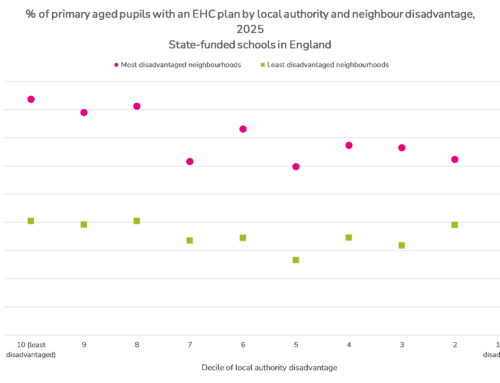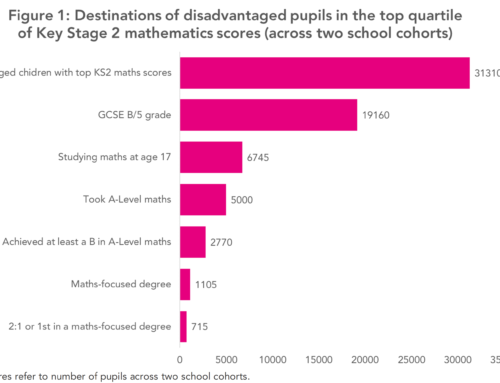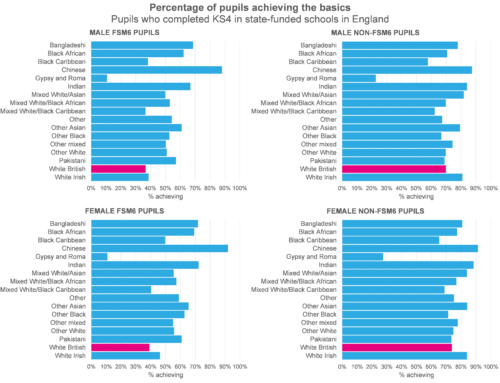Edited 10:21 on 13th December to include a link to previous research into delayed admissions
One of the things we’ve noticed working with Key Stage 1 data since the pandemic is an increase in the number of pupils taught in a year group that does not correspond with their chronological age, for instance pupils of Year 3 age being taught in Year 2.
In this article, we examine how the number of pupils taught out of year group has been changing over the last few years.
Data
We use data from the January School Census from 2008/09 to 2022/23.
We calculate a pupil’s chronological age as at the previous August using their year and month of birth. For example, a pupil born in September 2016 would have been 5 at the start of the 2022/23 academic year. This corresponds with Year 1.
Dates of birth in School Census aren’t always observed without error. It’s not unheard of to see pupils apparently in their 20s attending primary schools.
Assuming data errors are of similar volume across years, we identify pupils who are educated out of year group. In some cases, pupils will be taught alongside older pupils. But, for the most part, they will tend to be older than their classmates.
We limit the analysis to pupils of compulsory school age, i.e. aged 4 to 15 at the start of the school year.
Results
In January 2023, there were almost 40 thousand pupils taught out of year group. This is composed of 38 thousand pupils who were older than the year group expected given their chronological age, and just under 2 thousand who were younger than the year group in which they are taught.
The number of older pupils has more than doubled since 2017.
The size of the compulsory age school population has increased over the period shown in the chart, from 6.75 million in 2009 to 7.71 million in 2023.
We therefore represent the data as the percentage of the total number of pupils.
This shows an increase in the number of older pupils from 0.2% in 2017 to 0.5% in 2023.
It is much more common for primary-age pupils, particularly those in Reception to Year 2, to be taught out of year group.
Finally, we show some key characteristics of pupils taught out of year group compared to all other pupils.
Pupils who are older than the year group in which they are taught are far more likely to have been born in July or August than other pupils and more likely to have an Education, Health and Care plan (EHCP). It also appears to be the case that pupils who are younger than the year group in which they are taught are also more likely to have an EHCP.
Summing up
The last few years have seen an increase in the number of pupils taught out of year, particularly pupils who are older than the year group in which they are taught.
This is more common at primary, particularly Reception to Year 2, than at secondary.
The trend in increasing numbers appears to have started before the Covid-19 pandemic. However, it has since continued to increase. As comments below note, the increase began to occur following publication of guidance on the admission of Summer born pupils.
Want to stay up-to-date with the latest research from FFT Education Datalab? Sign up to Datalab’s mailing list to get notifications about new blogposts, or to receive the team’s half-termly newsletter.













Thanks for this interesting analysis. I wonder whether the trend at primary may partly be explained by the change of rules in 2015, which allowed parents to delay the start of schooling for a year and put their child into reception when they were 5. Before that, summer-born children were allowed to delay by a year, but many were forced to start in year 1. It could be that parents are becoming more aware of the option over time, as well as it being an effect of the pandemic.
Thanks very much Nicky- that’s certainly when the increase began to occur.
Hi the Summer Born Guidance was first published in 2013 with the first handfuls of summer born children starting school a year later in 2014/15/16. The numbers increased year on year after that. The recent DfE analysis said there were over 1000 delayed children across just 31 LAs in 2021. In 2016 there were 339 children delayed. So across all LAs this number will account for a good proportion of your increased numbers.
This may be of interest: https://assets.publishing.service.gov.uk/media/6565f94e750074000d1ded3c/Delayed_school_admissions_for_summer_born_children_2023.pdf
Thanks a lot Justine- very helpful.
The trend being down to summerborn children is also supported by your point that the out of cohort children are mainly in primary, and reception to Y2 particularly. Given the year on year increase in summerborns starting at CSA, there would naturally be a weighting towards younger children. The oldest CSA starters (of whom there are relatively few) have only just started secondary. I would also suggest that schools that agree a repeat of an early year such as reception or y1 tend to want to move the child back to their chronological cohort before the end of primary school (this is only for repeating, not for CSA starters) which again would weight the numbers towards those early years.
Interesting links to EHCPs. Is there any clear reasoning for younger EHCPs being in older classes – is this more of a trend in specialist settings so possibly more exposure to mixed-age classes?
Further to the comments from Justine and Katherine.. as the years go by, the number of pupils being taught OONAG in secondary schools will increase as the increased numbers of CSA-R starters move through the school years.
The number of children doing so may increase a little further, as the guidance for admissions authorities referenced in this article has been made more robust and clear. It does, however, remain a postcode lottery for parents making delayed entry requests to Reception, as a significant number of Academy Trusts, and to a lesser extent, some local authorities, appear ideologically opposed to allowing summer born children to start Reception a year later if the parents decide they are not ready to start school just after turning four years old.
Current Government guidance says that children who began in Reception at Compulsory School Age should remain in their adopted cohort for the remainder of their school life. There is a high bar for moving children to their chronological age group.